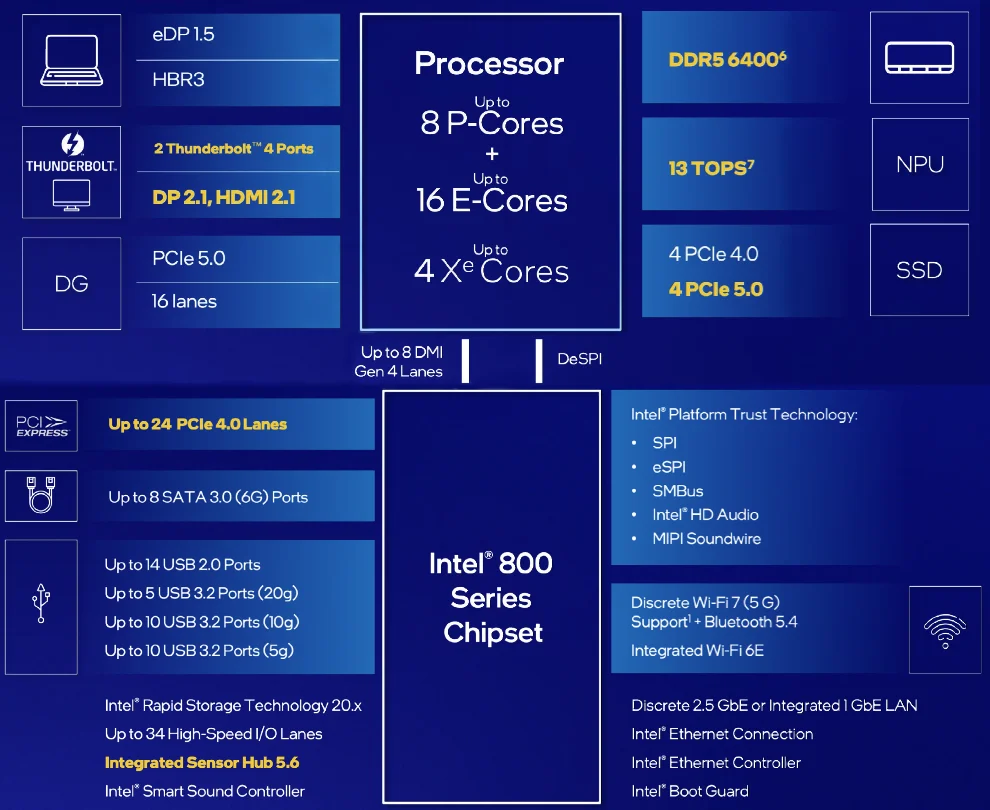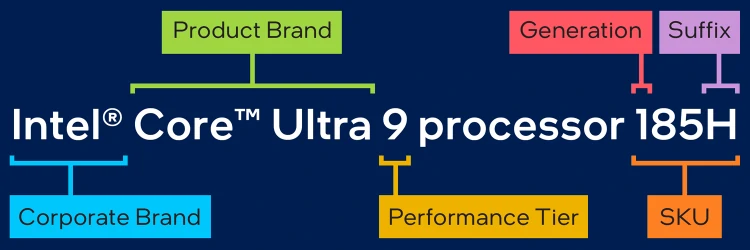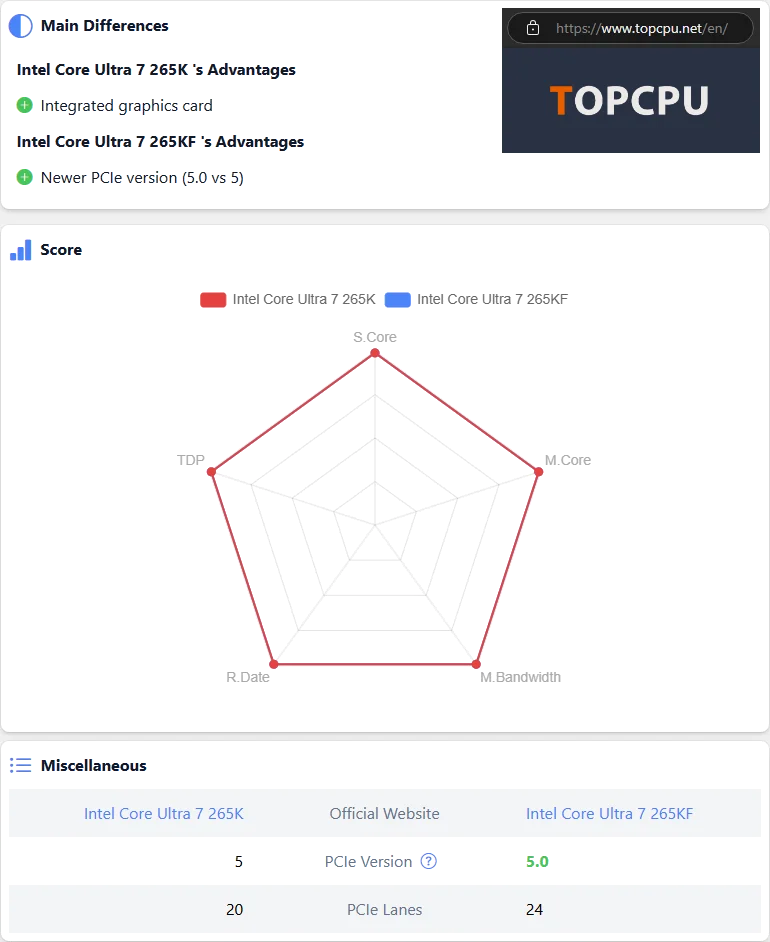Intel Chipset series 800 - Ultra processors |
Looks like Intel started behaving like Microsoft when they had multiple versions of 'Windows 10' at the same time. So now under the same generation number are the processors codenamed 'Raptor Lake' (10 nm) with the socket FCLGA 1700, and the processors 'series 2' (Ultra), codenamed 'Arrow Lake' (3 nm) with the socket FCLGA 1851 for desktop computers. Processors codenamed 'Lunar Lake' (3 nm) with socket FCBGA 2833 are used for laptops. Other types of processors have other code names and technologies.
The basic groups of Intel processors are:
Intel generally had a practice of first making processors for notebook computers, and then for desktop computers. The chipset was mostly the same. After in the 14th generation of processors, desktop processors were technologically improved in comparison to the already existing 'Meteor Lake' (7 nm) processors for notebook computers - 'series 1', new features were incorporated into both types of processors, resulting in 'series 2' (Ultra). The following figure shows the block diagram of the processor-chipset system, and the descriptions marked in yellow refer to newly added or improved features.

|
| Figure 3.5.68 Block scheme of Intel 800 series chipset and improved 14th generation processors. |
As these pages mainly describe only what is related to desktop computers, which always have more powerful processors compared to notebook computers, this page has been 'on hold' for some time. And now that the version of the processor for desktops has finally arrived, it is nicely written that the lithography is TSMC N3B (3 nm process), and the TDP for them is 125 W up to 250 W. Graphics cards are no better either. As far as I'm concerned, I don't need a heater in my house, so I'm on hold with regard to new technologies.
The result of all this is more expensive components and more powerful cooling systems (water), and technology that may not be completely backwards compatible for older devices to work properly in a SOHO environment (like Wi‑Fi 6E). However, a slightly more detailed description follows.
The technological process has been significantly improved. The layers of the processor elements are reversed compared to the representation in the figure 3.5.51 (right column), which means that the circuits that heat up more are on the side silicon substrates. Basic circuit groups of microprocessors are now:
Intel has changed the labeling of its products for all series of processors, so the nomenclature for the ULTRA series (generation) of processors is according to the following Figure.

|
|
| Figure 3.5.69 Method of labeling ULTRA series processors. |
About everything is clear in the description in the picture except for the suffix. Possible suffixes and their meaning are shown in the following table.
| Form / Function Type / Segment | Suffix | Optimized / Designed for |
| Desktop | K | High performance, unlocked |
| F | Requires discrete graphics | |
| S | Special edition | |
| T | Power-optimized lifestyle | |
| Mobile (Laptop and 2 in 1) |
HX | Highest performance, all SKUs unlocked |
| HK | Highest performance, all SKUs unlocked, less threads than HX | |
| H | Highest performance | |
| P | Performance optimized for thin and light laptops | |
| U | Power efficient | |
| Y | Extremely low-power efficient | |
| G1-G7 | Graphics level (processors with newer integrated graphics technology) | |
| Embedded | E | Embedded |
| UE | Power efficient | |
| HE | High performance | |
| UL | Power efficient, in LGA package | |
| HL | Highest performance, in LGA package |
The following table shows the features of Intel's flagship Intel® Core™ Ultra 9 Processor 285K and for the class a weaker processor in terms of performance without integrated graphics Intel® Core™ Ultra 7 Processor 265KF. Processors of the 'Ultra 9' series without integrated graphics are currently not available.
| Essentials | ||
| Processor series | Intel® Core™ Ultra 9 Processor 285K | Intel® Core™ Ultra 7 Processor 265KF |
| Product Collection | Intel® Core™ Ultra Processors (Series 2) | |
| Code Name | Products formerly Arrow Lake | |
| Vertical Segment | Desktop | |
| Processor Number | 285K | 265KF |
| Overall Peak TOPS (Int8) | 36 | 25 |
| Recommended Customer Price | $589.00 ~ $599.00 | $379.00 ~ $389.00 |
| CPU Specifications | ||
| Total Cores | 24 | 20 |
| # of Performance-cores | 8 | |
| # of Efficient-cores | 16 | 12 |
| Total Threads | 24 | 20 |
| Max Turbo Frequency | 5.7 GHz | 5.5 GHz |
| Intel® Thermal Velocity Boost Frequency | 5.7 GHz | N/A |
| Intel® Turbo Boost Max Technology 3.0 Frequency | 5.6 GHz | 5.5 GHz |
| Performance-core Max Turbo Frequency | 5.5 GHz | 5.4 GHz |
| Efficient-core Max Turbo Frequency | 4.6 GHz | 4.6 GHz |
| Performance-core Base Frequency | 3.7 GHz | 3.9 GHz |
| Efficient-core Base Frequency | 3.2 GHz | 3.3 GHz |
| Cache | 36 MB Intel® Smart Cache | 30 MB Intel® Smart Cache |
| Total L2 Cache | 40 MB | 36 MB |
| Processor Base Power | 125 W | |
| Maximum Turbo Power | 250 W | |
| Intel® Deep Learning Boost (Intel® DL Boost) on CPU | Yes | |
| AI Software Frameworks Supported by CPU | OpenVINO™, WindowsML, DirectML, ONNX RT, WebNN | |
| CPU Lithography | TSMC N3B | |
| Supplemental Information | ||
| Marketing Status | Launched | |
| Launch Date | Q4'24 | |
| Embedded Options Available | No | |
| Use Conditions | PC / Client / Tablet, Workstation | PC / Client / Tablet |
| Memory Specifications | ||
| Max Memory Size (dependent on memory type) | 192 GB | |
| Memory Types | Up to DDR5 6400 MT/s | |
| Maximum Memory Speed | 6400 MHz | |
| Max # of Memory Channels | 2 | |
| ECC Memory Supported | Yes | N/A |
| GPU Specifications | Without integrated GPU | |
| GPU Name | Intel® Graphics | |
| Graphics Base Frequency | 300 MHz | |
| Graphics Max Dynamic Frequency | 2 GHz | |
| GPU Peak TOPS (Int8) | 8 | |
| Graphics Output | DP2.1 UHBR20, HDM2.1 FRL 12GHz, eDP1.4b | |
| Xe-cores | 4 | |
| Max Resolution (HDMI) | 4K @ 60Hz (HDMI 2.1 TMDS) 8K @ 60Hz (HDMI2.1 FRL) | |
| Max Resolution (DP) | 8K @ 60Hz | |
| Max Resolution (eDP - Integrated Flat Panel) | 4K @ 60Hz | |
| DirectX Support | 12 | |
| OpenGL Support | 4.5 | |
| OpenCL Support | 3 | |
| Intel® Quick Sync Video | Yes | |
| # of Displays Supported | 4 | |
| Device ID | 0x7D67 | |
| Intel® Deep Learning Boost (Intel® DL Boost) on GPU | Yes | |
| NPU Specifications | ||
| NPU Name | Intel® AI Boost | |
| NPU Peak TOPS (Int8) | 13 | |
| Sparsity Support | Yes | |
| Windows Studio Effects Support | Yes | |
| AI Software Frameworks Supported by NPU | OpenVINO™, WindowsML, DirectML, ONNX RT, WebNN | |
| Expansion Options | ||
| Direct Media Interface (DMI) Revision | 4 | |
| Max # of DMI Lanes | 8 | |
| Intel® Thunderbolt™ 4 | Yes | |
| Scalability | 1S Only | |
| PCI Express Revision | 5.0 and 4.0 | |
| PCI Express Configurations | Up to 1x16+2x4, 2x8+2x4, 1x8+4x4 |
|
| Max # of PCI Express Lanes | 24 | |
| Package Specifications | ||
| Sockets Supported | FCLGA1851 | |
| Thermal Solution Specification | PCG 2020A | |
| Max Operating Temperature | 105 °C | |
| Advanced Technologies | ||
| Intel® Volume Management Device (VMD) | Yes | |
| Intel® Gaussian & Neural Accelerator | 3.5 | |
| Intel® Thread Director | Yes | |
| Intel® Speed Shift Technology | Yes | |
| Intel® Thermal Velocity Boost | Yes | |
| Intel® Turbo Boost Max Technology 3.0 | Yes | |
| Intel® Turbo Boost Technology | 2.0 | |
| Intel® 64 | Yes | |
| Instruction Set | 64-bit | |
| Instruction Set Extensions | Intel® SSE4.1, Intel® SSE4.2, Intel® AVX2 | |
| Idle States | Yes | |
| Enhanced Intel SpeedStep® Technology | Yes | |
| Thermal Monitoring Technologies | Yes | |
| Security & Reliability | ||
| Intel vPro® Eligibility | Intel vPro® Enterprise, Intel vPro® Platform | N/A |
| Intel® Threat Detection Technology (TDT) | Yes | N/A |
| Intel® Active Management Technology (AMT) | Yes | N/A |
| Intel® Standard Manageability (ISM) | Yes | |
| Intel® Remote Platform Erase (RPE) | Yes | N/A |
| Intel® One-Click Recovery | Yes | N/A |
| Intel® Hardware Shield Eligibility | Yes | N/A |
| Intel® Control-Flow Enforcement Technology | Yes | |
| Intel® Total Memory Encryption - Multi Key | Yes | N/A |
| Intel® AES New Instructions | Yes | |
| Secure Key | Yes | |
| Intel® Trusted Execution Technology | Yes | |
| Execute Disable Bit | Yes | |
| Intel® OS Guard | Yes | |
| Intel® Boot Guard | Yes | |
| Mode-based Execute Control (MBEC) | Yes | |
| Intel® Stable IT Platform Program (SIPP) | Yes | N/A |
| Intel® Virtualization Technology with Redirect Protection (VT-rp) | Yes | N/A |
| Intel® Virtualization Technology (VT-x) | Yes | |
| Intel® Virtualization Technology for Directed I/O (VT-d) | Yes | |
| Intel® VT-x with Extended Page Tables (EPT) | Yes | |
| Recomended OS | ||
| Microsoft Windows |
Windows 11 (24H2), Windows 11 (23H2), Windows 11 (22H2) - with NPU possibilities Windows 11 Family, Windows 10 (22H2) - without NPU possibilities |
|
Thanks to the latest Intel core and efficiency innovations, Intel Core Ultra desktop processors deliver a landmark reduction in power usage with up to 58% lower package power in everyday applications and up to 165 W lower system power while gaming. The new processor family combines improved efficiency with improved performance, also delivering up to 6% faster single-threaded and up to 14% faster multi-threaded performance over the previous generation. With complete AI capabilities powered by the CPU, GPU and NPU, enthusiasts get the intelligent and powerful performance they need for content creation and gaming, all with a reduced energy footprint. New hardware group is NPU (Neural Processing Unit), a low-power hardware solution, introduced with the Intel® Core™ Ultra generation of CPUs. It enables you to offload certain neural network computation tasks from other devices, for more streamlined resource management. OpenVINO supports the Neural Processing Unit (NPU), a low-power processing device dedicated to running AI inference. OpenVINO is an open-source software toolkit for optimizing and deploying deep learning models.
Be that as it may, Intel once again showed its development power.
SUMMARY:
The KF series of processors are essentially the same as the K series of processors, with the only difference being that they do not have integrated graphics and little part of security features. This makes them a great option for 'overclocking', and they are priced significantly lower than K series of processors. The default TDP for all processors is the same. Perhaps in a strict test of KF series of processors will show a lower value for TDP, especially the T series of processors.
A good site for comparing different circuit components can be found on the Internet, and its name and domain are shown in the next Figures in the upper right corner.

|
| Figure* 3.5.70 Comparison of processors K, KF and T series. ( + / - ) |
The author's assumption, however, is that it is a comparison of available factory data, and not a comparison of measured data. Still, the KF processor series would have to have a slightly lower consumption, as is the case with the T series which also has no integrated graphics? At the mentioned site, the description states the following for the T processor series: 'This is a processor manufactured by Intel using the 3 nm fabrication process, designed for Desktop platform, released on Dec 2024. It features a design of 8 big cores and 12 small cores to achieve 20 cores and 20 threads, with an ultra-high specification. The base frequency is 2.4 GHz, with a maximum turbo boost frequency of 5.3 GHz, TDP of 35 W, L3 cache high up to 24 MB with integrated graphics. It uses the Intel Socket 1851 socket.'.
|
Citing of this page: Radic, Drago. " Informatics Alphabet " Split-Croatia. {Date of access}; https://informatics.buzdo.com/file. Copyright © by Drago Radic. All rights reserved. | Disclaimer |